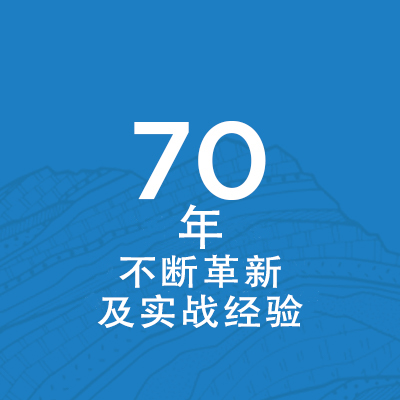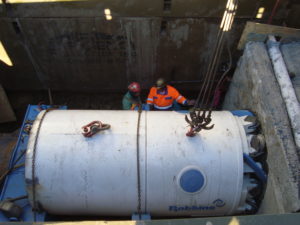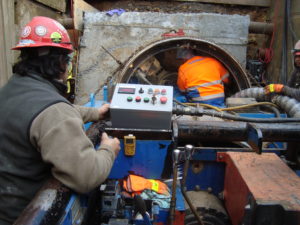
每种地质的方案:搜索我们的项目库
项目地图
重磅推出设备: 跨模式掘进机
我们的历史
一个创新的传奇
24/7 更新新闻
新闻简讯
行业观察:
罗宾斯博客
 The Iowan towns of Clinton, Camanche and Low Moor have been identified as communities in desperate need of updated wastewater treatment systems. The towns all have over 10,000 residents, but their water and sewer treatment plants are inadequate and often over capacity. In 2009, a statewide recovery program called I-JOBS was created in Iowa, and USD $20 million in project funding was allocated to improving water quality. These funds were set aside for water treatment projects in the three towns.
The Iowan towns of Clinton, Camanche and Low Moor have been identified as communities in desperate need of updated wastewater treatment systems. The towns all have over 10,000 residents, but their water and sewer treatment plants are inadequate and often over capacity. In 2009, a statewide recovery program called I-JOBS was created in Iowa, and USD $20 million in project funding was allocated to improving water quality. These funds were set aside for water treatment projects in the three towns.
The City of Clinton awarded their portion of the funding, USD $9.5 million, to general contractor Merryman Excavation. Illinois-based L.J. Keefe Co. was chosen as the sub-contractor for the project. The contract, known as City of Clinton Contract B Force Main, called for six crossings below roadways and rivers, three of which required TBM tunneling. The remaining three crossings required SBUs. Two Robbins SBU-As were chosen for the 26.2 m (250 ft) and 82.3 m (270 ft) runs, and a third Robbins motorized SBU (SBU-M) was selected for the 120.4 m (395 ft) crossing.
The 26.2 m (250 ft) and 82.3 m (270 ft) crossings undercut the Mississippi river, and were identified as hard rock bores of over 70 MPa (10,000 psi) UCS in which SBU-As would be the best choice. The longest crossing was below traffic-heavy Highway 67, and testing of the area revealed a mixed face of sand, clay and 70 MPa (10,000 psi) UCS hard rock. Due to the variable ground conditions, the contractor opted for a 1.8 m (72 in) SBU-M, the largest of its kind yet built.
The Small Boring Unit (SBU-A) is a hard rock and mixed ground circular cutterhead which utilizes an Auger Boring Machine (ABM) and steel casing. During excavation, the SBU-A is welded to the lead casing while the ABM provides torque and forward thrust to the cutterhead.
The SBU-A is available in diameters ranging from 600 mm to 1.8 m (24 to 72 in), and its single disc cutters are capable of excavating rock from 25 to over 175 MPa (4,000 to over 25,000 psi) UCS. The cutters penetrate the rock face, creating a “crush zone” through which fractures occur. Material between adjacent crush zones falls from the face into muck buckets in the cutterhead. A full face auger is used to transfer the muck for removal.
The SBU-A’s cousin, the SBU-M, is a motorized SBU used for longer bores and line-and-grade critical crossings. In similar fashion to the SBU-A, the SBU-M is welded or bolted to the lead casing of an ABM. The machine is continuously steered by way of an operator’s console in the rear shield. A laser targeting system is used to monitor the machine’s heading. These features allow for increased accuracy and continuous monitoring, which was needed on the 120.4 m (395 ft) bore due to the mixed ground geology, strict line-and-grade requirements, and crossing length.
 In November and December 2011, the 1.5 m (60 in) and 1.06 m (42 in) SBU-As, respectively, were launched 9.1 m to 10.6 m (30 to 35 ft) beneath a tributary of the Mississippi River. Each utilized an 18.3 m (60 in) ABM to excavate in the hard rock conditions. Both SBU-As broke through on time and within line-and-grade specifications. The first SBU reached completion on December 20, 2011, and its counterpart did the same on February 10, 2012. Each averaged advance rates of 6.1 m (20 ft) per day.
In November and December 2011, the 1.5 m (60 in) and 1.06 m (42 in) SBU-As, respectively, were launched 9.1 m to 10.6 m (30 to 35 ft) beneath a tributary of the Mississippi River. Each utilized an 18.3 m (60 in) ABM to excavate in the hard rock conditions. Both SBU-As broke through on time and within line-and-grade specifications. The first SBU reached completion on December 20, 2011, and its counterpart did the same on February 10, 2012. Each averaged advance rates of 6.1 m (20 ft) per day.
The 1.8 m (72 in) SBU-M was launched in January 2012 from a 7.6 m (25 ft) launch pit. Although the machine encountered an unexpectedly long drive of hard clay just 4.6 m (15 ft) into its bore, crews were able to keep moving by adding water through the cutterhead and the casing. This kept the muck coming through without contaminating the disc cutters.
Although challenging, advance rates of 6.2 m (20 ft) per day were maintained in the softer ground conditions. After about 70.1 m (230 ft) worth of clay, the machine hit solid rock for the remainder of the run. While in hard rock, rates increased to about 90.1 m (30 ft) per day.
On February 14, 2012, the SBU-M broke through into a receiving pit. It finished within line-and-grade requirements with very little deviation, even in the mixed face ground conditions during initial boring.

 Close
Close